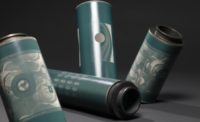Back in 2014, INEOS announced that they were halting the production of Barex resins, the acclaimed resins used in chemical-resistant packaging. The announcement shook the flexible packaging industry, as the resin had just begun to trickle into the narrow web arena at the time, particularly when it came to hard-to-hold applications, says Cindy Collins, Avery Dennison’s flexible packaging product manager.
“At the time, we had just started bringing Barex to the narrow web converter base, and then it’s going away,” she says. “It sent a panic into the industry as far as finding good barrier protection for hard-to-hold ingredients.”
However, Avery Dennison turned this negative news into an opportunity and got to work on a high-barrier replacement product that it could offer for hard-to-hold applications. After about 18 months of working and developing such a structure with a supplier, it debuted its ChemControl portfolio in June 2016 and formally unveiled it at Labelexpo Americas 2016 in September.
“It really comes alongside the trend of what’s filtering down into the narrow web converter base as far as opportunity,” Collins explains. “Very hard-to-hold cosmetics, anti-aging creams, essential oils – we’re also seeing a move, if you look in automotive, you’re seeing a lot of carburetor cleaners and wipes, a lot of those things are in individual packages as well. As it starts filtering down, as flexible packaging trends, everyone is trying to move into flexible packaging one-time use. The issue becomes the availability of structures that will hold these contents.”
Currently, the ChemControl portfolio, which is proprietary to Avery Dennison, consists of two products: ChemControl Ultra and ChemControl Ultra Plus. The former is acrylic-coated, polyester-faced lamination with a chemical-resistant sealant. It’s impervious to volatile ingredients and non-absorbent chemicals. Though it was designed with dry goods in mind, it’s also suitable for gels and lotions. ChemControl Ultra Plus is similar to the Ultra product, but for more extreme chemical resistance. Specifically, it’s been designed to resist chemical reaction and absorption while being impervious to volatiles and packet degradation.
“The design on the Ultra Plus is to be for those extremely hard-to-hold types of applications,” Collins says, noting the likes of fuel stabilizer and iodine. “Some of those are more problematic, you don’t want the odor or the ingredients to be able to absorb. You lose some of the effectiveness of what you’ve got in the package.”
Collins says that while two products have been developed as a replacement for Barex, the company plans to continue to work on and enhance the ChemControl portfolio. While she acknowledges that many in the industry pre-bought Barex upon news of its discontinuation, the resin isn’t likely to last through 2017 for most companies.
“For folks in the label market, they’re being asked about flexible packaging very regularly from their customer base and they’re exploring it,” Collins says. “It used to be shampoos and conditioners, and you’d have the basic structures that worked well. As the trends emerged, we started putting oil in things or adding fragrances, or instead of just the basic shampoo and conditioner line, now you have the more medicinal-type applications coming in with much more or harsher ingredients. They want to enjoy that same success in flexible packaging, the one-time use. But if the structures are not available, then you’re delaying. We’ve allowed that process to really speed up.”
Avery Dennison
(626) 304-2000; www.averydennison.com





